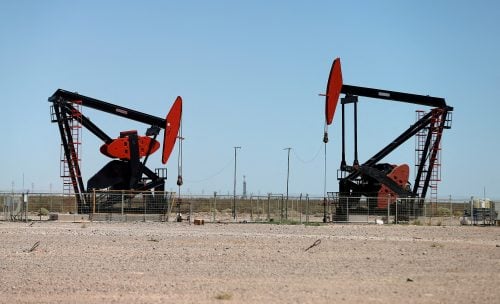Crude oil prices fell, during today’s trading, Thursday, April 6 (2023), for the second consecutive session; US economic data raised concerns about a possible global recession and reduced demand.
Prices are heading towards achieving weekly gains after OPEC + announced more production cuts and the decline in US oil stocks.
Crude oil prices rose for 4 consecutive sessions after the pledges of 9 OPEC + countries, led by Saudi Arabia, raised the total volume of coalition cuts to 3.66 million barrels per day, including a reduction of two million barrels in October, equivalent to about 3.7% of global demand.
Crude oil prices today
By 07:53 AM GMT (10:53 Mecca time), Brent crude futures – for June 2023 delivery – were down 0.41%, recording $84.64 a barrel.
West Texas Intermediate crude futures – for May 2023 delivery – fell by 0.46%, to record $80.24 a barrel, according to what was seen by the specialized energy platform.
And crude oil prices ended their dealings, yesterday, Wednesday, April 5, declining for the first session, after 4 sessions of gains, under pressure from fears of an economic recession that might limit demand.
Brent and West Texas Intermediate have risen about 6% so far this week, heading for 3 consecutive weeks of increase after OPEC+ countries pledged voluntary production cuts.
Oil market analysis
“Crude Oil’s rally has paused as it has been battling headwinds created by weak economic data, and this has offset more positive fundamentals,” ANZ Research said.
The US services sector slowed more than expected in March as demand slowed, while a measure of prices paid by service firms fell to its lowest level in nearly 3 years; This gave the Fed a boost in fighting inflation.
New Zealand’s central bank raised interest rates more than expected on Wednesday, and India is likely to be the next country in line to raise benchmark interest rates.

economic slowdown
Meanwhile, employment opportunities in the United States fell in February to their lowest level in nearly two years; This indicates a decline in the labor market.
A string of weak economic data soured market sentiment; This fueled recession fears and prompted investors to adopt risk aversion strategies.
On the other hand, the dollar index, which measures the US currency against a basket of 6 major currencies, rose today, Thursday, rebounding from its lowest level in two months.
A stronger dollar usually dampens demand for oil, as crude becomes more expensive for holders of other currencies.
“The slowdown in the US economic outlook is weighing on the upside in US crude oil prices, but we still expect a further rally in oil prices through the end of the quarter,” wrote analysts from the National Australia Bank Baden Moore and Adam Skelton.
demand for oil
Supporting the market, Saudi Arabia, the world’s largest oil exporter, raised the prices of its main crude to Asian buyers for the third month in a row.
“This indicates an increase in demand strength in the region,” ANZ said, according to Reuters.
Government data showed that US oil inventories fell by 3.7 million barrels last week, an increase of 1.5 million barrels from expectations.
Gasoline and distillate inventories also fell more than expected, falling by 4.1 million barrels and 3.6 million barrels, respectively.
Oil price forecast
Christophe Rohl, former chief economist of the British oil company BP, said that global economic growth is the single most important driver of global demand for oil, and it seems to me that China and the Group of Seven major countries are facing a slowdown in growth, not an acceleration.
He added, in remarks to the specialized energy platform, that the increase in Chinese demand after the end of the Covid lockdown has been greatly overestimated by the International Energy Agency and other oil analysts.
He pointed out that against this background, he believes that crude oil prices will continue in a corridor between 80 and 86 dollars for a longer period, until the next surprise occurs, similar to the cuts of OPEC + countries.
He explained that the cuts made by 9 OPEC + countries, led by Saudi Arabia, which raised the coalition’s cuts to about 3.6 million barrels, will not be sufficient to bring crude oil prices closer to $100 a barrel.
related topics..
Also read..

Leave a Reply